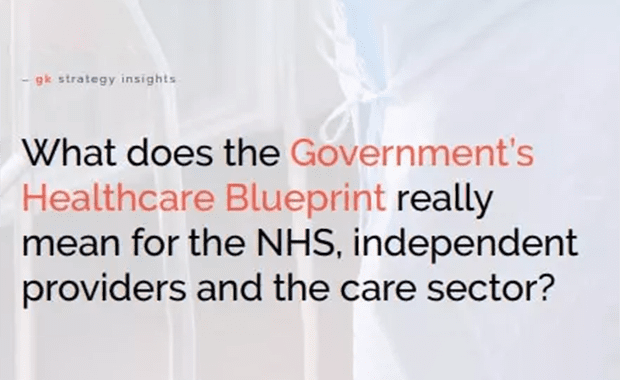GK Adviser and former chairman of the FCA, John Griffith-Jones shares his thoughts of the three key challenges for the financial services sector.
Download the report here: The good, the bad and the ugly

GK Adviser and former chairman of the FCA, John Griffith-Jones shares his thoughts of the three key challenges for the financial services sector.
Download the report here: The good, the bad and the ugly

Sir Peter Hendy’s interim Union Connectivity review was published today (10th March). The Review was launched in October 2020 to consider transport connectivity across the United Kingdom and to identify a series of recommendations that will support the Government’s strategic ambitions. Hendy’s final recommendations are expected in the Summer.
Despite being an independent review, the highly political mandate from Government is evident even in this initial iteration. From ‘levelling up’ to the environmental agenda and the future of the Union, the Review is shaping up to be the latest in a long line of reports which elucidate the Johnson administration’s post-COVID, post-Brexit vision for the UK. Hendy appears highly conscious of his work’s position in the greater scheme of things – citing the recent Integrated Rail Plan, the Regional Air Connectivity Review and the upcoming Transport Decarbonisation Plan as parallel and interdependent pieces of work.
As the name suggests, where the Union Connectivity Review is most additive is on the question of how transport links could better operate between nations of the UK. The headline proposal is for a new ‘pan-UK’ strategic transport network to work alongside the existing strategic networks of each nation. This would not alter the operational responsibilities of Highways England, Transport Scotland and others, but would complement them with cross border strategies and assessments.
The final Review will provide an assessment of the ongoing costs of such a network, including preliminary costing and timescales for the proposed fixed link between the British mainland and Northern Ireland.
Only at subsequent budgetary events – most notably the anticipated 2021 Spending Review – will we see how the Government’s priorities fall between cross-border connectivity and other transport projects, including the flagship HS2 project. From a political perspective a Conservative government might assess that apart from diluting the pro-independence feeling in Scotland, there is more to be gained from shoring up their voter-base in the Midlands and the North, than from creating better cross-border links.
On top of the political considerations, there is growing talk of unease from the Treasury about the level of investment chalked up for transport projects versus digital infrastructure – the so-called ‘steel versus fibre’ debate. This rift is one reason given for the continued delay to DfT’s publication of the Rail Network Enhancements Pipeline, which is hotly anticipated by the sector.
If these strands of thought prevail, a new pan-UK strategic transport network could end up far more strategy than substance.

The second week of February was National Apprenticeship Week, and providers, employers and assessors of apprentices waited with bated breath for the plethora of announcements that would come thick and fast to support the sector and encourage greater uptake of apprenticeships by employers. They were disappointed.
Last month’s celebration of the Government’s flagship training and employment policy was a muted affair, with the DfE concentrating on awareness-raising and success stories rather than solid policies. This happened despite the broad consensus currently shared between policymakers and businesses that apprenticeships can provide a solution to a number of issues created or exacerbated by the pandemic. For instance, they can assist in reducing youth unemployment, and allow businesses to meet the new needs of the economy post-pandemic, by retraining existing staff.
Of course, over the past 12 months, the Government has been tinkering with its apprenticeships policy. Most notably with the introduction of the “opportunity guarantee” in June of last year, in which the Prime Minister promised that every young person who wanted an apprenticeship should get one. This featured a cash handout to employers for every apprentice under 25 that they hire. However, this was widely seen at the time as being not nearly enough to offset the risk employers would be taking on by hiring new staff in such an uncertain time. More broadly, this policy has been accompanied by several other announcements in related areas – kickstart, traineeships, t-levels, vocational training – a veritable scattergun of ideas.
This was crystalised with the Spending Review at the end of last year, and the Skills for Jobs White Paper, announced in January, which proposed a number of structural changes to apprenticeships and other similar policies to make them more flexible for employer needs.
While it is good to see the Government prioritising this area, the lack of focus on any one scheme (of which apprenticeships is the most promising) risks confusing and diluting the impact of their initiatives. Apprenticeships work best when they are part of a pathway from education to employment, bridging the gap from school leavers to full-time employees, with a ramp on and off to ensure individuals are not left out from the next stage of their development.
Apprenticeships are fortunate to have some effective advocates both within Parliament and the sector – and it is time for the Government to work more closely with those who want to utilise apprenticeships, and to remove the stumbling blocks that COVID has put in their way. Training providers and employers of apprentices now have an opportunity to engage constructively in this conversation, and stand to reap the rewards of well-trained, motivated staff while Britain builds back better.

COVID has clearly forced a rethink on the role of technology in education. The longstanding minister for school standards, Nick Gibb, who has until recently shown little enthusiasm for technology, announced in January that the Government is exploring a strategy for the creation of “a more resilient education system based on firm digital and technological foundations”. But what will this mean in practice, and how will this agenda be advanced in a department where the digital agenda is far behind departments like health?
As pupils were ordered to stay at home this January, the question of a crisis in education became a reality. Nobody needs reminding that pupils’ education has now seen almost a year of huge disruption, exacerbated by personal traumas and reduced social interactions. No group of pupils is affected more than disadvantaged students, and many who fall into this category also lack the technological and familial support to transition smoothly to a remote or home learning environment.
A January report by the Sutton Trust found that just 5% of state school teachers say all their students have adequate access to devices for remote learning. Parents on lower incomes are twice as likely as more well-off parents to find homeschooling harder now than in March 2020. Most worryingly, 85% of teachers think the lockdown and associated disruption will increase the attainment gap between disadvantaged pupils and their better-off peers. This is corroborated by other research across the education sector, not least from the Education Policy Institute, who has researched extensively the impact of lockdown measures on the attainment gap.
While the picture looks bleak for closing the divide, there is an opportunity for a reset in thinking to ensure that some of these challenges and barriers are eroded in the years ahead. Most starkly, there is a huge opportunity to upgrade the education system to give a greater role to digital and technology infrastructure, and levelling up access to these tools for the most disadvantaged.
To coin a phrase, in every crisis there lies opportunity. At least, that seems to be the thinking of School Standards Minister, Nick Gibb, following his speech at BettFest, a virtual EdTech event on the 20th January. Gibb is a renowned educational conservative, with a proclivity for traditional policies and a broad tech-scepticism. For example, he has favoured a ban on mobile phones in schools. However, the current pandemic and related crises appear to have triggered a rethink for Gibb. During the event, he said that the Government was exploring a strategy for the creation of “a more resilient education system based on firm digital and technological foundations”.
Gibb went on to say that the Government was not looking at the use of technology for the sake of it, but for using it as a means to support the delivery of “a consistently high-quality education system”. The EdTech sector, who may have found the Government snail-paced in its adoption of technology in recent years (particularly since Gavin Williamson replaced the more tech-enthusiastic Damian Hinds), this may just signal a turning point.
While it is still early days for this strategy, the effects of inadequate digital and technology infrastructure are being felt by pupils every day. Therefore, the time is now for the EdTech sector to engage with the Government to help it develop and deliver a strategy that is right not just for pupils now, but for the pupils of the future. ‘Build back better’ has become the slogan of policymakers across the Johnson administration, and the crisis facing the education system offers a prime opportunity to put this into practice with a legacy of technological solutions.
If you are an EdTech provider with an interest in what this strategy could look like, or you would like to establish relationships with stakeholders to amplify your voice in this area, please do get in touch with us at ian@gkstrategy.com or on 020 7340 1150.

GK is delighted to have appointed Scott Dodsworth as a Director. He joins the senior management team and senior advisers, to strengthen the Agency’s integrated strategic communications and specialist political due diligence team.
Scott will work alongside other senior advisors such as former ministers David Laws, Phil Hope and Alistair Burt to support clients, as well as contributing to the Agency’s new business and growth efforts. The hire follows significant new client wins across the Agency’s health and education portfolios, and wider public affairs services.
Scott brings over 15 years’ experience of agency and in-house public affairs and government relations having worked in senior roles at defence firm BAE Systems plc and global communications agency, Hill + Knowlton Strategies.
Company Founder and CEO, Robin Grainger, said:
“We are pleased to welcome Scott to GK as the Agency grows and strengthens its work in political advisory and strategic communications. Scott brings great experience and respected counsel and will complement our wide-ranging capabilities.
“Our award-winning approach combines the rigour and discipline of our political risk and due diligence practice, with media and strategic communications expertise. Scott is a great addition to our senior team.”
Scott Dodsworth, Director, said:
“I am excited to join GK, a firm with great energy and strong respected reputation in strategic advisory and political analysis. I look forward to working with a range of clients across sectors on their relationships and reputation with government and society.”

GK’s Strategic Advisors and former health ministers Alistair Burt and Phil Hope share their thoughts on the Department for Health & Social Care’s recent proposals for healthcare reform and integration and they explore what this means for investors and providers.
GK are experts in health and social care policy, working across the system with care providers and med tech and life sciences companies. We support investors to evaluate political, policy and regulatory risk in the investment process, and support independent providers and charities to engage and shape the political and policy landscape.
Download their analysis here: Healthcare Blueprint
For more information or to set up a meeting to discuss the health and care landscape further please contact robin@gkstrategy.com